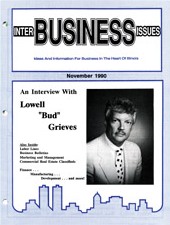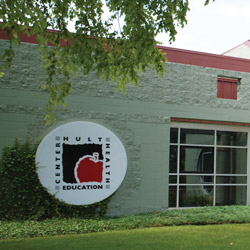
Peoria 1989, the All-American city. "Rising Star" among medium-sized American cities. The 1980s have brought some of the worst and some of the best to our city. We're seeing some corporate expansion, some new companies, office buildings, shopping centers, motels and restaurants. Economic recovery is a long process, and there are many questions to be answered as we enter 1990:
- Can real economic development in Peoria live up to the good national press it is now getting?
- Will unified city leadership emerge to take advantage of the unique economic opportunities that Peoria seems to now have?
- Just how much has Peoria really diversified economically?
- Will the city of Peoria be able to reconcile its budget woes and operate in a fiscally sound manner while finding the money to fund long-overdue capital improvements?
- What will downtown Peoria look like in the year 2000?
Blue collars and lunch buckets symbolized Peoria's workforce for the biggest part of the century right up into the late 1970s. In the ‘80s, however, the scenario began changing rapidly. As much as any city in the United States, Peoria mirrored the gigantic transition of the American workforce from a manufacturing to a service orientation. According to Martin Mini of the EDC, the Peoria-area labor force currently has over 60 percent of its workers in service-related industries. That compares to the approximately 75 percent working in manufacturing jobs in the ‘70s. As you would expect, new development in the Peoria area centers around the service sector: new retail outlets, restaurants, insurance offices, marketing and consulting offices, medical facilities, and yes, even prisons.
IBI EXPANDS
Beginning in March, InterBusiness Issues will expand to a small magazine format. The response of the Peoria business community to our newsletter format over the past year has been extremely positive. We plan to continue the concise, professional look as we create more room to address the issues that are important for the continued success of your company in the Peoria market.
TOUTING PEORIA
The National Civic League, who awarded Peoria the All-American City status, is running advertisements about Peoria's winning of the award nationwide on radio and newspapers, hoping to encourage other cities to seek the status. The ads represent hundreds of thousands of dollars of free advertising for the city and show a familiar bumper sticker of years past: "Will the last person to leave Peoria please turn out the lights?" That is followed by a brief summary of Peoria's economic turnaround: "A new mayor and 5,000 volunteers teamed up to solve Peoria's problems. They launched a business incubator program, raised $2 million, created 9,000 new jobs, reduced unemployment to six percent and cleaned up streets and parks all over the city."
The National Association of Realtors again listed Peoria as the number-one metropolitan area for affordable housing, of 83 surveyed nationwide, with the median price of an existing house at $47,200.
According to the March 1990 Inc. magazine rating of the most entrepreneurial cities in America, Peoria ranks No. 89 out of 192 cities, up from No. 172 one year ago, and the highest ranking of any city in Illinois. The rankings were based on job growth, business starts and proportion of high-growth companies. Other Illinois cities were ranked as follows: Chicago, 105; Bloomington, 149; Rockford, 172; Springfield, 186; and Rock Island, 187.
Mayor Maloof, in his best role as Peoria's #1 PR professional, spent a five-minute segment on CBS' This Morning show in late July, touting the economic development advantages of Peoria to the nation. The story contrasted Peoria's current good times with recessed conditions in other parts of the country.
ONE-YEAR ANNIVERSARY
One year ago this month, we began publishing InterBusiness Issues. At the time, the city was buzzing about: a new downtown mall, a new baseball stadium, several new major shopping centers, Peoria's growing fiscal problems, lack of cohesive direction by local leaders, and Southtown development, among other issues. It's surprising how little things change in a year.
Pity the Peorian who is just returning from a sabbatical and is trying to find his insurance office, favorite retailer, car dealer or medical office. Chances are fairly good that at least one of them has moved in the past 12 months. New office and retail buildings. New car lots. Bigger and better. New and improved. It's surprising how much things change in a year.
THE NEWS AT BIG YELLOW
Caterpillar Inc. announced that President Donald V. Fites will take over as chairman and CEO upon George Schaefer's retirement, as the company enacts a major restructuring of its top executives.
Caterpillar Inc. made big news on the local healthcare front in July, announcing that its 16,000 domestic salaried and management employees will share in the cost of health benefits beginning in 1991. Cat workers currently pay no deductibles or co-payments for insurance coverage, and have traditionally had the Cadillac of coverage. Health benefits cost Caterpillar $221 million in 1989.
September 30, 1991 is a date that you will begin hearing more and more about. That's when the UAW contract with Caterpillar Inc. expires. Strike talk has already started, centered around several issues:
- Caterpillar's decision to hire outside companies for janitorial and lawn work
- Medical insurance deductibles
- Outsourcing of manufacturing work.
Contract talks, which will likely begin in July, could be held in Peoria rather than St. Louis as they were in 1982, '85 and '88. iBi

 The $3 million Marvin Hult Health Education Center had its grand opening in late October. Its goals include education in the areas of drug abuse, nutrition, hygiene and teen pregnancy.
The $3 million Marvin Hult Health Education Center had its grand opening in late October. Its goals include education in the areas of drug abuse, nutrition, hygiene and teen pregnancy.